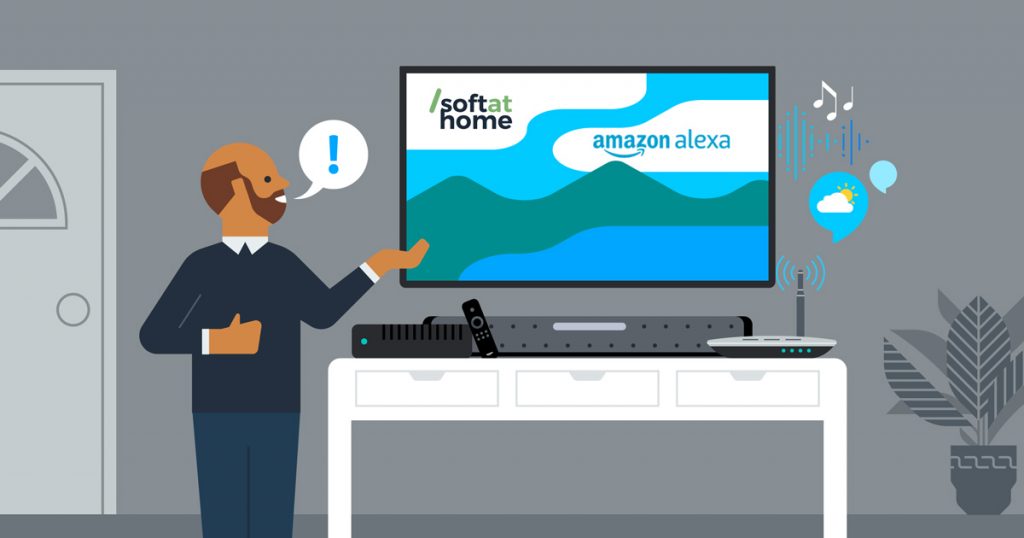
After more than 40 years of operation, DTVE is closing its doors and our website will no longer be updated daily. Thank you for all of your support.
Why voice technology in general – and Amazon Alexa in particular – is becoming central to the user experience?”
Book a call with SoftAtHome and Amazon Alexa to talk about your first voice-enabled project.
David Souhami – Director of Innovation and Product Marketing, SoftAtHome, talks about the rise of voice technology for TV.
What are the main trends that you see in SoftAtHome’s market and how central is voice technology to your strategy?
When you’re faced with a daunting variety of services spanning everything from entertainment to the Internet of Things (IoT), with each offering a different user experience, voice is the most natural way to bring it all together.
The most disruptive and impactful trend we see is the advent of the over-the-top distribution as a business model for all these services, old and new. OTT has brought many new innovative services within easy reach of the end subscriber. Some of these, such as the Amazon Echo, come with voice control. However, within the individual user’s home network, there is a risk of fragmentation of both the user experience and the technology that enables it.
The home network has always been SoftAtHome’s focus. As IoT devices start to grow in popularity, we believe that operators have an opportunity to help users take more effective control over their digital lives at home. Voice is the most natural way of doing this.
How important is voice control to end-consumers and why are SoftAtHome and Amazon the right partners to address this market?
SoftAtHome is a company created by operators, for operators, and it provides a measure of risk control for ISPs. Amazon is the global leader in voice technologies. Thanks to SoftAtHome’s status as a qualified Alexa Solution Provider, it is enabled to offer the cutting edge of voice technologies and AI to its operator customer base, running on various operator devices such as set-top boxes, WiFi repeaters and smart speakers. Alexa is now present in over 80 countries in 15 languages and handles billions of interactions per week.
To date, based on Amazon’s publicly available data, there have been over 3.5 billion Alexa utterances on video-enabled devices. Amazon cites the statistic that over 80% of customers using the FireTV Cube device also use it for home automation, and that voice browsing and utterances per customer are six times that of other devices that don’t have Far Field voice technology. Amazon has more than 50 apps with expanded in-app voice controls available worldwide in their FireTV App Store.
According to Omdia’s survey data from April this year, 19% of the internet population across eight national markets – the US, UK, France, Germany, Mexico, Brazil, India and Japan – currently use voice commands to operate video devices. According to Omdia, the two main uses for voice command are content discovery and navigation.
In parallel, it has been established that customer churn is mainly due to poor content discovery, so a voice-enabled offer is therefore a sensible strategic move to improve user retention.
How does SoftAtHome enable operators to deploy Amazon Alexa, including control of the set-top box from an Amazon Echo?
SoftAtHome uses embedded software to integrate Amazon’s Alexa Voice Service (AVS) and provides SmartScreen SDK integration within various devices such as set-top boxes, smart speakers, gateways and Wi-Fi repeaters in far-field and push-to-talk.
To enable operators to deploy the devices of their choice, SoftAtHome has created an Audio Lab. Device manufacturers can undertake voice calibration thanks to this Amazon-certified Lab to pre-certify audio devices for Alexa. SoftAtHome then customizes Alexa Video skills to deliver the best voice experience for TV and IoT services.
SoftAtHome helps service providers deploy a complete end-to-end Amazon Alexa voice environment. Thanks to cloud components deployed by SoftAtHome, the operator will enable use of Alexa from its devices, such as set-top boxes and repeaters, and allow users to control them remotely from an Amazon Echo.
In a commercial deployment, SoftAtHome also provides a service-level agreement for end-to-end system performance.
What are the stages of a typical operator integration project and what is the end result for the user?
Our work on a Deutsche Telekom AG (DTAG) project where SoftAtHome integrated Alexa into Deutsche Telekom’s Magenta smart speaker provides a good case study. The SoftAtHome team comprised software architects, developers and audio experts.
The overall project began in late 2018, starting with the device design. This first Alexa integration took about six months including scoping the software integration and testing up to the point of securing certification with Amazon for music, acoustic tests, functional tests and security certification. To perform acoustic tests SoftAtHome used a purpose-built room that complied with Amazon’s requirements.
Scoping typically includes activities such as defining which music service to enable: Spotify, Amazon Music and later Apple Music. We find that an agile project approach allows us to easily change the scope for future releases.
In this project we enabled dual assistants within the same device so that users can start a request by saying “Hello Magenta” or “Alexa”, according to their preference.
Why is now the right time to invest in this technology, and what is your ambition?
In 2020, several large operators within the EU including Free, SFR, Deutsche Telekom and Vodafone launched Alexa-integrated products, and Orange and Telefónica also have voice in their offerings.
Our ambition is to offer the best-in-class, most future-proof solution to operators around the world looking to integrate voice technology into their home network environment.
Explore Your Development Options
Book a free one-on-one call with SoftAtHome and Amazon Alexa to talk about ideas for your first voice-enabled project.
Schedule a consultation with us. We look forward to talking with you!
This is sponsored content


